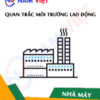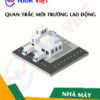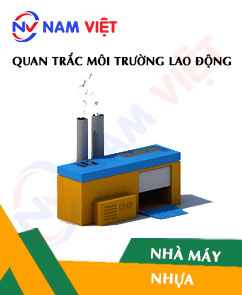Occupational environment monitoring of an ice cream manufacturing factory
99,000 ₫
Note: The above price is calculated for one sample, and the price may fluctuate depending on the area of the environment to be monitored and market movements. For more accurate pricing support, please refer to the price list or contact our consulting staff directly.
Monitoring the environment of an ice cream manufacturing factory is a session of collecting, analyzing, and evaluating factors at the workplace that may harm workers health.
Table of Contents
Toggle1. Overview of Ice Cream Manufacturing Factories
a. What is an Ice Cream Manufacturing Factory?
Factory producing ice cream is a facility specialized in manufacturing frozen or fresh ice cream. This factory uses ingredients such as milk, sugar, fruit, and flavorings to produce ice cream under strict technological and quality standards. The ice cream products are stored at low temperatures to maintain freshness and quality.

b. Production Processes in Ice Cream Manufacturing Factories
Production processes in ice cream manufacturing factories may include:
- Ingredient preparation: Ingredients such as milk, sugar, fresh cream, and fruit are prepared for use in the production process.
- Mixture preparation: Ingredients are mixed in specific proportions to create the ice cream mixture.
- Freezing: The ice cream mixture is placed in ice cream machines to freeze and form the final product.
- Mixing and packaging: Ice cream is mixed with optional flavors and fruits before being packaged into retail units or freezers for storage.
- Quality inspection: Each batch of ice cream is inspected to ensure the product meets quality and food safety standards.
- Transportation and distribution: Ice cream is transported to retail outlets and distributed to consumers.

c. Machinery Used in Ice Cream Manufacturing Factories
Machinery used in ice cream manufacturing factories includes:
- Ice cream machines: The primary equipment for ice cream production, using freezing principles to produce ice cream from ingredients such as milk, sugar, butter, fruit, nuts, chocolate, etc.
- Ice cream packaging machines: Equipment for packaging ice cream into boxes, bags, or trays, usually featuring functions for portioning, packaging, and printing production dates.
- Mixing machines: Equipment used to mix ingredients during production. It may be used to blend ice cream with other components such as fruit, nuts, chocolate, etc.
- Whipping machines: Equipment used to whip ice cream to create a smooth and creamy texture.
- Freezers: Equipment to store ice cream at low temperatures to maintain quality and prolong freshness.
- Molding machines: Equipment used to create special shapes for ice cream, such as hearts, stars, flowers, etc.
Depending on production scale and technology, ice cream factories may also use machines such as egg beaters, rolling machines, canning machines, etc.

d. Occupational Diseases Workers May Encounter in Ice Cream Manufacturing Factories
Potential occupational diseases for workers in ice cream manufacturing factories include:
- Skin diseases: Workers exposed to chemicals and ice cream ingredients may experience dry or damaged skin, dermatitis, allergies, eczema, and other skin conditions.
- Respiratory diseases: Workers may inhale harmful fumes, dust, or smoke during production, leading to respiratory problems such as asthma, bronchitis, or pneumonia.
- Hand and wrist disorders: Handling machinery may cause strain, leading to musculoskeletal issues such as carpal tunnel syndrome, repetitive strain injuries, and inflammation.
- Hearing problems: Working in noisy environments may cause ear-related issues, including tinnitus and hearing impairment.
- Eye problems: Exposure to dust and small particles may cause dryness, irritation, conjunctivitis, or other eye conditions.
- Mental health issues: Work pressure and time constraints may lead to stress, depression, and anxiety.

e. Common Types of Ice Cream on the Market
Common ice cream types on the market include:
- Fresh cream ice cream: Made from fresh milk, sugar, whipping cream, and various flavors.
- Popsicles: Made from ice cream powder, sugar, flavorings, and other additives, in stick or capped forms.
- Ice cream sandwiches: Two layers of cookies with a layer of ice cream in between, sometimes with toppings or candy pieces.
- Cotton candy ice cream: Made from sugar, food coloring, flavorings, and foaming agents, creating a fluffy ice cream resembling cotton candy.
- Ice cream bars: Made from ice cream powder, sugar, and foaming agents, available in various flavors and colors.
- Ready-to-eat ice cream: Made from fresh cream or ice cream powder, pre-packaged and ready to consume immediately.
- Soft serve ice cream: Soft and smooth ice cream made from powder, sugar, milk, and foaming agents, commonly served in ice cream shops and fast-food restaurants.

2. Overview of Occupational Environment Monitoring Services
a. What is Occupational Environment Monitoring for Ice Cream Manufacturing Factories?
Occupational environment monitoring (or workplace environmental measurement) at ice cream manufacturing factories involves collecting, evaluating, and analyzing environmental indicators in the workplace to implement timely measures, minimize environmental hazards to worker health, and prevent occupational diseases. Monitoring the occupational environment is mandatory for ice cream manufacturing factories.
Occupational environment monitoring is essential for protecting and enhancing worker health, as the workforce is the primary resource directly generating profit for the company. Workers frequently exposed to risk factors and occupational hazards beyond allowable limits may experience health issues and occupational diseases.
REGISTER FOR OCCUPATIONAL ENVIRONMENT MONITORING SERVICE
b. Nam Viet’s Occupational Environment Monitoring Program
Nam Viet’s occupational environment monitoring program is designed by engineers specialized in occupational safety and environmental protection. Aiming to ensure workers’ health and safety, the program employs modern measurement methods to monitor air, water, microclimate, physical factors, dust, and other workplace environmental elements. This program is crucial in maintaining a safe working environment and protecting workers’ health.
Additionally, Nam Viet’s monitoring program plays a significant role in researching and developing new solutions to improve workplace environmental quality. With the dedication and professionalism of the monitoring experts, Nam Viet’s proprietary monitoring program represents a breakthrough in occupational safety management and environmental protection in Vietnam.

c. Standardization in Occupational Environment Measurement Procedures
Standardization in Nam Viet’s occupational environment measurement procedures is essential for ensuring the accuracy and reliability of results. The program follows standards and procedures recognized by the Ho Chi Minh City Department of Health. This ensures that the collected data are reliable for evaluating the workplace environment and making decisions to improve conditions for worker health protection.
These standardized procedures also guarantee that measurements are conducted by highly qualified monitoring experts with years of experience, allowing managers and specialists to trust Nam Viet’s results and make informed decisions for occupational health and environmental safety.
By applying standardization in workplace measurement, Nam Viet demonstrates its commitment to providing a safe working environment and protecting worker health, while actively contributing to improving occupational safety and environmental management quality in Vietnam.
d. Ice Cream Factory Monitoring Reports
Occupational environment monitoring results are prepared according to Form No. 04, Appendix III, issued with Decree 44/2016/ND-CP and made in 02 copies: 01 copy sent to the contracting workplace and 01 copy retained by the monitoring organization.
The retention period for occupational environment monitoring results is indefinite as required by law.

e. Frequency of Occupational Environment Monitoring as Required by Law
According to Clause 2 of Article 18 of the Law on Occupational Safety and Hygiene 84/2015/QH13, employers must organize workplace monitoring to evaluate harmful factors at least once a year.
f. Deadline for Submitting Occupational Environment Monitoring Reports as Required by Law
The deadline for submission is before December 31 each year. Enterprises at manufacturing facilities must submit occupational environment monitoring reports to the local Department of Health where the facility is headquartered and where workers are employed.
When there are changes in technology, production processes, or during facility upgrades that may introduce new hazardous factors to worker health, enterprises must update occupational hygiene records to reflect the harmful factors requiring monitoring.
g. Penalties for Violations of Occupational Environment Monitoring by Employers
According to Article 27 of Decree No. 12/2022/ND-CP dated January 17, 2022, regulating administrative penalties in labor, social insurance, and Vietnamese workers working abroad under contract:
- Clause 2: Fines ranging from 2,000,000 – 5,000,000 VND for employers who fail to publicly inform workers at the monitored workplace and the location of hazard assessment immediately after receiving monitoring results and hazard evaluation results.
- Clause 3: Fines ranging from 20,000,000 – 40,000,000 VND for employers who do not conduct occupational environment monitoring to control health hazards according to the law.
- Clause 4: Fines ranging from 40,000,000 – 60,000,000 VND for employers who collude with monitoring organizations to commit fraud in occupational environment monitoring but have not reached criminal liability.
3. Harmful Environmental Factors for Workers in Ice Cream Manufacturing Factories
Harmful environmental factors for workers in ice cream manufacturing factories may include:
- Noise: Employees in ice cream factories may be affected by noise from equipment operating during production, causing stress and affecting hearing.
- Temperature: Working in cold environments to produce ice cream can cause back pain, joint pain, and other health issues, as workers are exposed to low temperatures for extended periods.
- Chemicals: During ice cream production, chemicals such as preservatives, colorants, flavorings, and thickeners may be used. Exposure to these chemicals can be harmful to workers’ health.
- Air pressure: Workers may be exposed to equipment operating under high or low pressure, leading to potential health issues.
- Voltage: Ice cream production equipment may use high voltage, posing a danger to workers if not handled correctly.
- Lighting: The working environment in ice cream factories may lack natural light, which can affect workers’ vision and health under poor lighting conditions.
REGISTER FOR OCCUPATIONAL ENVIRONMENT MONITORING SERVICE
4. Measures to Improve the Working Environment in Ice Cream Manufacturing Factories
Measures to improve the working environment in ice cream manufacturing factories may include:
- Provide full personal protective equipment and ensure proper usage.
- Regularly inspect and maintain factory machinery and equipment to ensure worker safety.
- Adjust equipment and production processes to minimize the impact of noise, lighting, and temperature on workers’ health.
- Provide adequate drinking water, maintain hygiene, and ensure sanitation facilities to reduce the risk of infections and illnesses.
- Ensure proper ventilation to minimize toxic gases, dust, and chemical vapors.
- Train employees on occupational health and safety, including prevention and emergency response procedures.
- Implement full and accurate compliance with occupational safety regulations and guidelines.
- Apply pollution control measures, including noise control and proper waste management.
- Conduct periodic safety and health assessments to ensure compliance with laws and occupational safety procedures.
- Regularly conduct occupational environment monitoring in factories, collecting and analyzing harmful factors for workers, and adjust risks to prevent occupational diseases.
5. Benefits of Periodic Monitoring in Ice Cream Manufacturing Factories
An Toan Nam Viet provides enterprises with great benefits when using occupational environment monitoring services according to Decree 44/2016/ND – CP on managing and controlling harmful factors in the working environment affecting workers.
- Enterprises can proactively control harmful factors in factories or workshops.
- Receive consultation and recommendations to reduce harmful factors and improve workplace quality.
- Indirectly protect human resources, a key factor in business development.
- Reduce the impact of occupational diseases on health, minimizing future treatment costs.
- Improved worker health leads to better product quality and consistent production output.
- Comply with occupational safety laws, avoiding legal risks.
- Enhance credibility and professionalism, thereby elevating the enterprise’s brand value.
Nam Viet’s environmental monitoring service is a solution to reduce occupational disease risks, contributing to a clean and high-quality working environment.

6. Nationwide Occupational Environment Monitoring Center
Occupational Environment Monitoring Center of Nam Viet is a professional unit specializing in monitoring and measuring occupational environment quality across all provinces in Vietnam. With an experienced team of monitoring specialists, the center uses modern measurement equipment to ensure accuracy and reliability.
In addition to providing monitoring services, the center assists clients in planning, handling, and tracking occupational environment issues. Following the principle “customer-centered,” the center prioritizes client satisfaction, meets all client needs, and commits to providing the best solutions for enterprises.
REGISTER FOR OCCUPATIONAL ENVIRONMENT MONITORING SERVICE
With investment in technology, equipment, and human resources, Nam Viet’s monitoring center has become a reputable unit in occupational environment monitoring in Ho Chi Minh City, with the following goals:
- We always value brand reputation and service quality.
- We provide clients with the best and most suitable solutions.
- Alongside experienced Masters and Engineers, aiming to protect the environment and benefit enterprises.
- By choosing Nam Viet Environmental Monitoring, your company will receive professional service from experts in monitoring, along with the best cost incentives.
The occupational environment monitoring process at Nam Viet includes the following steps:
- Before monitoring, we ensure that all machinery and equipment used for monitoring are calibrated and compliant with legal regulations.
- Conduct the full monitoring procedures as committed to the Department of Health.
- Report monitoring results honestly to the employer.
- If results indicate unsafe conditions, Nam Viet will assist with corrective measures, and the factory will implement the following:
- Implement measures to improve working conditions, minimize harmful factor impact, and prevent occupational diseases.
- Organize health checks for early detection of occupational and work-related diseases for workers in unsafe positions.
- Provide material compensation for workers according to labor law regulations.

7. Occupational Environment Monitoring Price List
To help enterprises conduct occupational environment monitoring professionally and effectively, Nam Viet provides clients with a price list for occupational environment monitoring services that is high-quality and reasonably priced.
- Our price list provides detailed information on the costs of monitoring services, including transportation, measurement, analysis, and reporting. Clients can fully trust the accuracy and reliability of our monitoring reports.
- We commit to offering competitive and reasonable prices and are always ready to answer any questions about monitoring services promptly and professionally.
- With Nam Viet’s price list, clients can easily select service packages that suit their needs. We guarantee the highest satisfaction with professional service quality.
No comments yet












Review Occupational environment monitoring of an ice cream manufacturing factory
There are no reviews yet.